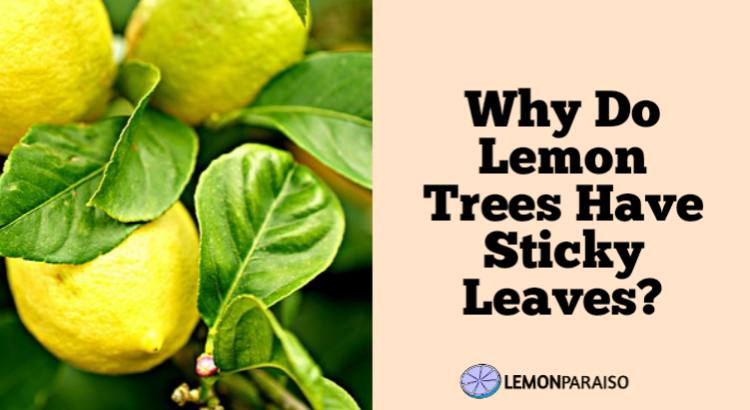Why Do Lemon Trees Have Sticky Leaves?

Picture this: a vibrant lemon tree, with lush green leaves glistening in the sunlight, promising a bountiful harvest of zesty fruits. However, the idyllic scene can quickly turn sour when those once pristine leaves become mysteriously sticky. This sticky situation can be a cause for concern for any citrus enthusiast. In this article, we’ll explore the perplexing phenomenon of sticky lemon tree leaves, delving into ten possible reasons behind this issue.
10 Reasons Why Lemon Tree Leaves Get Sticky
1. Aphid Infestation:
A common culprit for sticky lemon tree leaves is an invasion of aphids, tiny insects that feed on the sap of the plant. As they pierce the plant’s vascular system, they excrete a sugary substance known as honeydew, which coats the leaves and creates a sticky film. This sticky residue not only attracts ants but can also lead to the growth of sooty mold, further compromising the overall health of the lemon tree. Controlling aphids through natural predators or insecticidal soap can help alleviate this stickiness.
2. Scale Insects:
Scale insects are another potential menace to lemon trees, causing leaves to become sticky. These pests attach themselves to the plant and feed on its sap, secreting honeydew in the process. The resulting stickiness can be a breeding ground for various fungi, posing a threat to the lemon tree’s well-being. Regular inspection and the application of horticultural oils can aid in preventing and managing scale insect infestations.
3. Whitefly Presence:
Whiteflies, tiny insects resembling small moths, can infest lemon trees and lead to sticky leaves. Similar to aphids and scale insects, whiteflies secrete honeydew as they feed on the plant’s sap. This honeydew buildup attracts ants and can contribute to the development of sooty mold. Introducing natural predators like ladybugs or using insecticidal soap can help keep whiteflies in check.
4. Spider Mites:
Spider mites are microscopic pests that can infest lemon trees, puncturing plant cells and causing sap to ooze out. This sap, when left unchecked, can coat the leaves, creating a sticky surface. Regularly spraying the lemon tree with water and introducing predatory mites can help control spider mite populations and mitigate the stickiness.
5. Fungal Infections:
Certain fungal infections, such as powdery mildew or sooty mold, can also lead to sticky lemon tree leaves. These infections thrive in humid conditions and feed on the sugary honeydew produced by sap-sucking pests. Proper ventilation, spacing between trees, and the application of fungicides can help prevent and manage fungal infections, reducing the stickiness on the leaves.
6. Over-fertilization:
Believe it or not, over-fertilization can be a contributing factor to sticky lemon tree leaves. Excessive amounts of nitrogen in the soil can stimulate rapid growth, leading to an overproduction of sap. This excess sap can result in sticky leaves. Balancing fertilization practices and ensuring the application of the right nutrients in appropriate quantities can prevent this issue.
7. Excessive Watering:
In some cases, sticky leaves on a lemon tree may be attributed to overwatering. When a lemon tree receives more water than it can absorb, the excess moisture can cause the sap to exude from the leaves, creating a sticky residue. Proper irrigation practices, allowing the soil to dry out between waterings, can help mitigate this problem.
8. Environmental Stress:
Lemon trees are sensitive to environmental stressors such as extreme temperatures, drought, or nutrient deficiencies. When stressed, the tree may produce more sap than usual, resulting in sticky leaves. Ensuring the tree’s overall health through proper care, including adequate watering, nutrient balance, and protection from extreme weather conditions, can help prevent environmental stress-related stickiness.
9. Residue from Pesticides:
The use of pesticides on or around lemon trees may leave a residue that can contribute to sticky leaves. It’s crucial to follow recommended application guidelines, choosing pesticides that are safe for citrus trees. Thoroughly rinsing the tree after pesticide application can help prevent sticky residues and protect the plant’s overall health.
10. Excretion of Sugary Substances:
Sometimes, lemon trees may excrete sugary substances through their leaves naturally. While this occurrence is less common, it can lead to sticky leaves. Ensuring the tree is otherwise healthy and implementing good gardening practices can minimize the impact of this natural excretion.
In conclusion, identifying and addressing the root cause of sticky lemon tree leaves is crucial for maintaining a healthy and productive citrus orchard. By understanding the various factors that contribute to this stickiness, citrus enthusiasts can implement effective strategies to restore their lemon trees to their vibrant, sticky-free glory.

